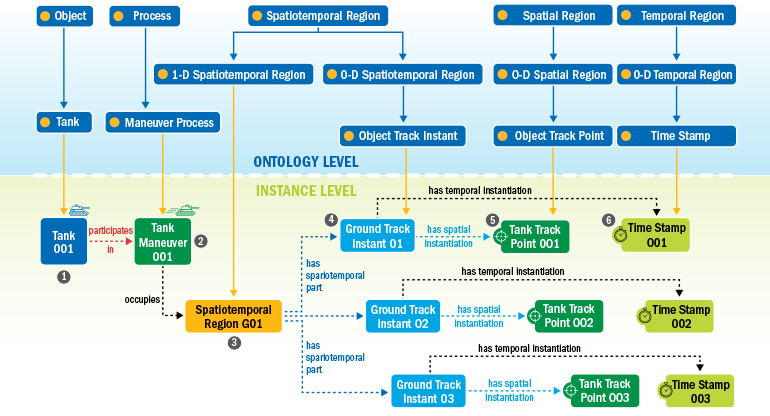
JADC2: Getting to Real-Time Object Data and Tracking in All Battlespace Domains
A computable reasoning framework of space-time enables joint all-domain command and control for DoD

Blog Posts
Joint all-domain command and control, or JADC2, is the Department of Defense (DoD) effort to produce a singular command and control (C2) network capable of linking all U.S. military sensors and fires, across all domains, in any conflict region. JADC2’s unifying connection of platforms, systems, and weapons from all the armed services branches will allow commanders to effectively achieve battlespace superiority through distributed sensing and actions. For example, information received from a U.S. Army tank could lead to a rapid Navy aircraft response with shared situational awareness.
JADC2 will drive command-and-control modernization as well as multi-domain integration for the DoD in an ever-evolving battlespace with near-peer adversaries and novel threats. With the JADC2 architecture integrating C2 data from across air, sea, land, space, and other warfighting domains, the DoD will accomplish joint all-domain operations with ubiquitous data and AI-assisted data transport and decision-making, among many converged capabilities.
Establishment and adoption of standards for capturing, defining, and transmitting this data will be needed, but the goals expressed for JADC2 require more than that.
Achieving JADC2 must also entail computationally assisted reasoning of hundreds, if not thousands, of material objects during a conflict. The individual services currently use their own incompatible networks to track these objects, be they Army and Marine Corps vehicles on the ground and Navy and Air Force fighter jets in the skies. A logical framework that expresses space-time (the spatiotemporal dimension) must serve as the foundation for semantic integration and computationally assisted reasoning across all the information systems in a fully connected JADC2 environment.
In other words, a logical, interoperable semantic framework will allow for reasoning and analysis about one type of object moving in one domain that can be applied in other domains to better integrate command and control. At the heart of this framework is a logically sound, universal spatiotemporal ontology that serves as the foundation for semantic integration, leading to truly interoperable data and information exchange (while allowing the services to maintain often dissimilar terminologies).
What is it that can be defined within space and time? How can a plethora of data feeds having both spatial and temporal elements be logically linked in a way that we can perform computationally assisted reasoning, using intelligent agents, of the information from the JADC2 battlespace level? To answer these questions, it is helpful to analyze the movement of a U.S. Army M1A1 Abrams main battle tank, designated in the chart below as “Tank_001” and participating in a maneuver process across space and time.
Tank_001’s onboard sensor tracks and transmits its location every 10 seconds; it records and sends MGRS (Military Grid Reference System) coordinates with a time stamp. As this space-time sensor captures the tank’s movement, crew members record their activities via communications devices, i.e., other sensors. There is a precise account of what Tank_001 was doing at every recorded point in space-time, e.g., engaging a target at MGRS VT009885 on 24JULY2019 at 07:25:20. In JADC2, this electronic record not only will be valuable to Army decision-makers but also to joint all-domain operations commanders.
From such a record, we can build a computable ontology and machine-readable reasoning framework. If taken up by the DoD service components, the proposed JADC2 spatiotemporal ontology would apply to all objects moving through space-time in all domains, enabling semantic integration and reasoning of data from all networks. It is built around six classes of entities, each of which is depicted in the graphic:

Numbers one through six in the graphic are:
1. Material Object (such as the M1A1 Abrams tank or an F-35 jet)
2. Process (such as the tank’s maneuver process or an aircraft’s flight pattern)
3. 1-Dimensional Spatiotemporal Region (which is a span of space-time)
4. 0-Dimensional Spatiotemporal Region (which is a point in space-time)
5. 0-Dimensional Spatial Region (which is a point in space designated by MGRS coordinates)
6. 0-Dimensional Temporal Region (which is a point in time designated by a time stamp)
The next step in building the JADC2 spatiotemporal ontology is establishing the relationships between these classes of entities so that a human or computer can reason with them. From the six entities, it can be concluded that a Material Object participated in a Process occupying Spatiotemporal Regions, and so on. The goal is to have a set of logically sound assertions that are computable and consistent across IT systems.
With the entity classes and logic curated into a web ontology language and data exchange format called OWL-RDF, any computer can derive meaning from data coming from main battle tanks, ships, spacecraft, and other objects and render knowledge graphs like the one depicted in the graphic.
This rather small ontology module facilitates the semantic integration and computationally assisted reasoning about discrete domain objects tracked by disparate information systems. A data-rich common operating picture (COP) logically integrating ground vehicles, ships, aircraft, dismounted troop formations, unmanned vehicles, and other objects on the move reveals behavioral patterns indicating what is truly happening. JADC2 commanders will then be able to quickly determine optimal courses of action and weapons to bear to bring about the most decisive effects expeditiously from the best asset.
JADC2 is an important effort for national security. SAIC is exploring technologies to link real-time object data to the COP via our spatiotemporal ontology, as part of a comprehensive JADC2 solution. This linkage of streaming data will allow us to employ intelligent algorithms to quickly discern significant patterns in battlespace activity and support decision-making superiority in JADC2 operations.
Co-written with Forrest Hare, Ph.D., SAIC solutions architect, cyberspace operations
For more on joint all-domain command and control, visit SAIC's JADC2 solutions site.
MORE ONTOLOGY AND SEMANTIC FRAMEWORK EXPERTISE FROM SAIC: Ontologies for data fusion and reasoning rise with growth in advanced analytics


